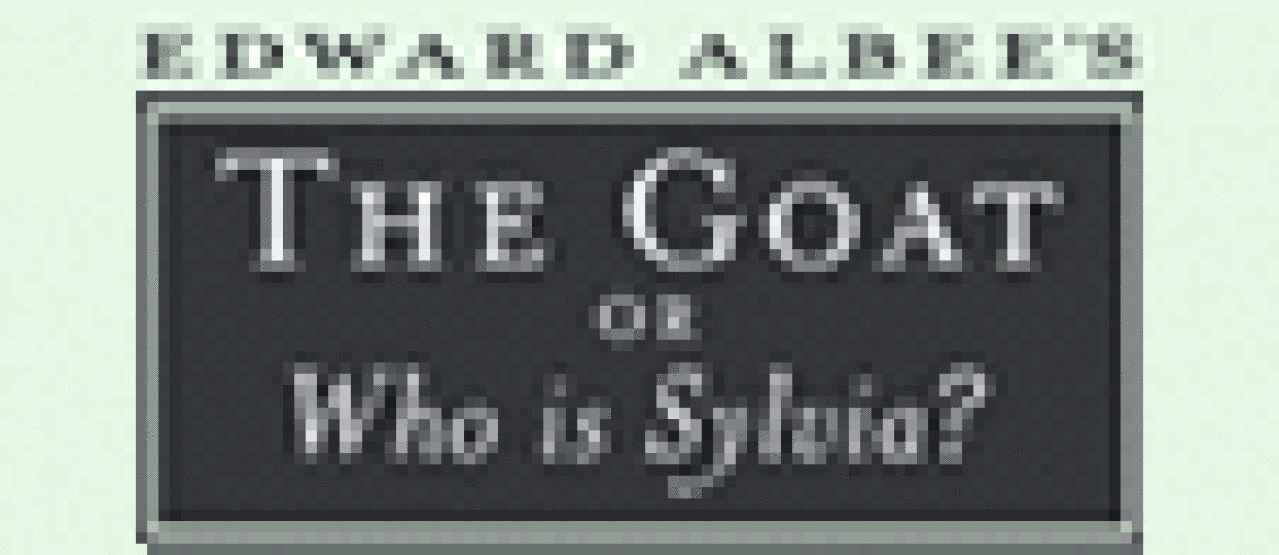The Goat, or Who is Sylvia?
Field came to prominence as a sitcom actress in Gidget and The Flying Nun, then — on winning her second Oscar in 1984 for Places
in the Heart — famously cried “You like me, you really like me!” from the podium. In her Broadway bow as Albee’s outraged Stevie, she emerges not only as a theater actress to be liked but as one to be respected and lauded. The wholly honest quality she possesses on big and little screens appears to be innate, something she can project without requiring multiple takes. When discovered here arranging flowers (theatrical shorthand implying command of a clockwork household, used mockingly by Albee), she looks to be right where she belongs.
In the middle scene of Albee’s three-scene piece, when Stevie is hounding (if that’s the right word) her architect husband to tell her every detail of his bizarre relationship, Field is so heated that sparks practically fly off of her. When she pastes a civil smile on her face as she scornfully asks him how his day has been otherwise, her disdain is fathoms deep. Later, sinking into the despair caused by her realization that something irreparable has torn the tissue of their love, she becomes so throttled that she seems to break out in a cold sweat. Finally putting a halt to a pottery-smashing spree in which Stevie indulges, Field makes mountainous the declaration that what has passed between her and Martin is something that “cannot be dealt with.”
Though there are moments in the spiky duologue where Field’s flares of anger begin to seem repetitive, it’s a problem that’s only partially hers. Albee would help her (or any other actor) out by cutting away the extraneous, redundant dialogue in this extended sequence. By
the time the play ends, Field has proven (as Anne Heche is doing a few blocks north in Proof) that, though she has infrequently performed on stage, it’s a natural habitat for her. In the wine-red sweater and tan slacks she wears during two-thirds of the play, she is reminiscent of Barbara Bel Geddes, who reigned on Broadway stages in the
’50s and ’60s — and that’s no small compliment.
Bill Irwin, under David Esbjornson’s fraught direction, stands toe to toe with Field — often literally. In his previous work, Irwin has frequently allowed himself to be too twee for endurance (e.g., when indulging himself in Samuel Beckett’s Texts for Nothing). Portraying Albee’s conflicted character, he cuts all of that out. Here is a man anguished by a romantic obsession, and Irwin — with his barely finished face and supple, mime’s body — gets it all. Martin is a tangled ball of emotions from his entrance, when he can’t quite remember why he’s come into the room, until his eventual realization that his unstoppable passion has destroyed the world over which he has tried to exercise control. Even if Irwin grimaces a little too often and is given to too much finger pointing, his is a noble take on the role.
Field and Irwin are noticeably better matched as Stevie and Martin than were their predecessors, Mercedes Ruehl and Bill Pullman. Since Ruehl is an imposing woman and Pullman rightfully played Martin as emotionally compromised, the two of them looked as if they would have been better suited to another Albee clash of domestic titans, Who’s Afraid of Virginia Woolf?. That their characters were nuts about each other never seemed entirely credible. When Field stands next to Irwin, she is shorter than he and therefore seems more vulnerable. The fact that they are so believable as a happy, well-matched couple makes all the more shattering Albee’s point that, in relationships, there are some betrayals too extreme to be overcome.
That blood-chilling point of his remains something worth taking home, even though the play is still problematic — no matter how many awards have come its way and no matter how smug the dramatist has been when receiving them. Yes, it’s probably true that Albee intended The Goat, or Who is Sylvia to incorporate aspects of Greek tragedy. (John Arnone clearly underlines this with his design for Stevie and Martin’s house, in which tall white columns are featured along with a few pieces of tribal art. The raised area at the back also suggests an altar for sacrifices.) But the bow to tradition doesn’t mean that this play, in which a man gets his goat and then loses her, is ever anything more than an attenuated skit — and, in its earlier moments, a very funny one.
Like Albee’s previous piece, The Play About the Baby, The Goat is too long by at least a third. The section in which Martin tells the goat news to his best
friend Ross (Stephen Rowe) seems to last forever, and Stevie’s pot-throwing fit could also be trimmed extensively. Since this is a play in which the audience is asked to believe that a man loves a goat who loves him back, it would seem that the thing to do is to move it past an audience as fast as possible. Sure, the goat is a metaphor for something or other; but plays in which the metaphor is stressed more than the surface reality of the situation tend to run out of steam quickly.
One last point: Audiences seem to have no trouble accepting the whole goat thing in The Goat, perhaps because they go along with it as something too extreme to be believed and therefore harmless; yet they gasp when Martin is kissed by his gay son Billy (Jeffrey Carlson, in a portrayal that remains strong) in a genuinely touching father-son encounter. This reaction indicates that, while attempting to shock audiences into re-examining their prejudices, Albee doesn’t quite know what society’s intolerances continue to be. Maybe there’s a sustained play to be written on that subject.











